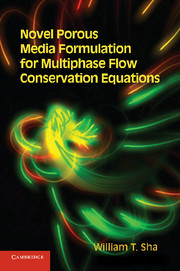Book contents
- Frontmatter
- Contents
- Figures and Table
- Foreword
- Foreword
- Foreword
- Nomenclature
- Preface
- Acknowledgments
- 1 Introduction
- 2 Averaging relations
- 3 Phasic conservation equations and interfacial balance equations
- 4 Local volume-averaged conservation equations and interfacial balance equations
- 5 Time averaging of local volume-averaged conservation equations or time-volume-averaged conservation equations and interfacial balance equations
- 6 Time averaging in relation to local volume averaging and time-volume averaging versus volume-time averaging
- 7 Novel porous media formulation for single phase and single phase with multicomponent applications
- 8 Discussion and concluding remarks
- Appendix A
- Appendix B
- Appendix C
- Appendix D
- References
- Index
Preface
Published online by Cambridge University Press: 07 October 2011
- Frontmatter
- Contents
- Figures and Table
- Foreword
- Foreword
- Foreword
- Nomenclature
- Preface
- Acknowledgments
- 1 Introduction
- 2 Averaging relations
- 3 Phasic conservation equations and interfacial balance equations
- 4 Local volume-averaged conservation equations and interfacial balance equations
- 5 Time averaging of local volume-averaged conservation equations or time-volume-averaged conservation equations and interfacial balance equations
- 6 Time averaging in relation to local volume averaging and time-volume averaging versus volume-time averaging
- 7 Novel porous media formulation for single phase and single phase with multicomponent applications
- 8 Discussion and concluding remarks
- Appendix A
- Appendix B
- Appendix C
- Appendix D
- References
- Index
Summary
This book marks the culmination of a long and exciting career that began in the early 1960s. After I completed my PhD coursework in nuclear engineering at Columbia University, I joined the Atomic Power Division at Westinghouse Electric Corporation (WAPD), where I participated in the final phase design of the world's first pressurized water reactor (PWR) for production of power, Yankee Rowe. After I worked at WAPD for one year, I was selected as the recipient of the Westinghouse Doctorate Scholarship. I returned to Columbia University to complete my doctoral dissertation and received a doctor of engineering science degree in January 1964. After rejoining WAPD, I was assigned to develop the THUNDER computer code for “an integral calculation of steady-state three-dimensional nuclear–thermal–hydraulics interaction,” which consisted of a two-group neutron diffusion code and the THINC, a thermal–hydraulics interaction subchannel code. The detailed documentation of the THUNDER code is described in a WAPD-7006 report dated January 1967, written by William T. Sha and Samuel M. Hendley and labeled Westinghouse Confidential. We published a short paper on the THUNDER code in the Transactions of the American Nuclear Society 8(1) (1965) pp. 203–204, but there were no other external publications. The reactivity feedbacks due to thermal hydraulics, including subcooled boiling and bulk boiling, control rod insertion, dissolved boron poison in the moderator, and local fuel pellet temperature (Doppler effect), were explicitly accounted for. Looking back, I realize that this assignment was very advanced at the time, and I learned a lot. After we completed the THUNDER code, I did some calculations using the code for PWRs, which clearly showed significant benefits in reducing hot channel factors.
While I was working on THUNDER, I carefully examined the governing equations used in the code. I noticed that the Boltzmann transport equation was approximated in the form of two-group diffusion equations for the neutronics part of the code and a set of partial differential equations for conservation mass, momentum, and energy for the thermal hydraulics part used in the THINC subchannel code. I developed a simplistic logic to convince myself that the thermal-hydraulics analysis is much more difficult to converge to a solution (or more nonlinear) than the neutronics (reactor physics) calculation for the following reasons. In general, most engineering applications may be divided into three disciplinary areas: (1) solid mechanics for stress and strain analysis, where the interactions of molecules of solid structures are very strong, but the displacement of these molecules is very little; (2) gas dynamics analogous to the neutronics calculations described here, where the interactions between the gas molecules (or neutrons) are minimal, but the displacement of gas molecules (neutrons) is large; and (3) thermal hydraulics for fluid flow with heat transfer analysis, where the interactions between the molecules of fluids are very strong and the displacement of these fluid molecules is very large. Because of the small displacement of molecules in solid structures and very little interaction between gas molecules (or neutrons) in gas dynamics (reactor physics calculations), one can simplify or linearize the corresponding governing equations for both the solid mechanics and the gas dynamics. For the thermal hydraulics analysis, both the interactions and the displacement of fluid molecules are, respectively, very strong and large. Hence, the fluid mechanics with heat transfer is the most difficult subject. Also, I realized that for the neutron transport, we use Boltzmann's equation with integrals, but not for the conservation of mass, momentum, and energy equations for multiphase flow, which are also transport equations for mass, momentum, and energy. Why do they not have integrals? It took me many years to find the answer. This is one of the reasons I have written this book.
- Type
- Chapter
- Information
- Publisher: Cambridge University PressPrint publication year: 2011

